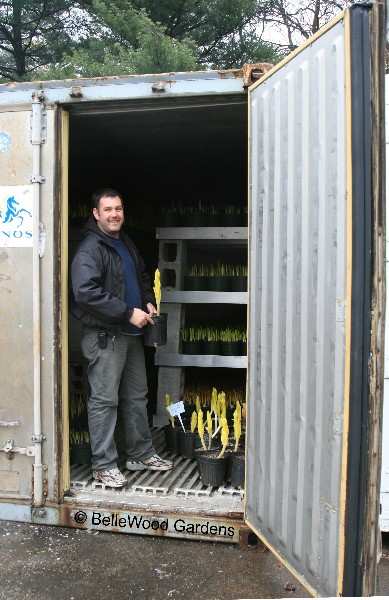
Tuesday, 21 April & Thursday, 30 April 2009
The Glory of Dutch Bulbs at the New York Botanical Garden
It's going to be wonderful, 50,000 bulbs and companion plants at the New York Botanical Garden, all in bloom in May, and it is more of a tour de force than it sounds. The exhibition in the Enid Haupt Conservatory opens on May 1st and does not close until June 7th. Think about this for a minute. The plan is to have bulbs in bloom later than they would naturally flower. Coaxing bulbs into early flowering is so easy even a child could do it. This exhibition, however, is just the opposite. Rather than flowering early, what's wanted is to delay the bulbs and have them flower later than they would naturally perform in the garden. Nice challenge for Marc Hachadourian, Manager of the Nolen Greenhouses for Living Collections.
Needing to convince endless pots of bulbs that they're growing in Maine and not next door to Manhattan, Marc rented two huge refrigerated cargo containers. With their controlled chilling capacity, greenhouse space, and lots of help, Marc managed to pull it off, retarding the bulbs' growth so they flowered on the exhibition's cycle rather than that of Mother Nature.

Work potting the bulbs was done primarily in November and December,
with just a few handled as early as October. The range of bulbs
includes a diversity of daffodils in yellow and white and blends

Temporary shelving was created using concrete blocks and sturdy mesh shelving.
Growing in the dark, the bulbs have blanched, pale foliage. Light will green it up.
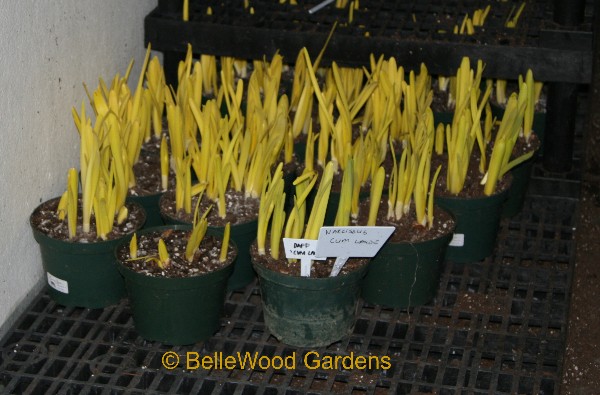
From the refrigerated cargo containers pots of bulbs are shifted into the state of the art Nolen Greenhouses. They're on benches, in the outer, glass-fronted hallway, outdoors in Tuesday's light drizzle - pots of bulbs all over the place. And not just bulbs. Keep in mind that the exhibition will include foxgloves and delphiniums, phlomis and primroses, pink dogwood trees in full flower. And towering echiums that were started from seed last year.
Tulips include single late, parrots, fringed, viridiflora, and lily flowered. "No early tulips such as Tulipa greigii or T. kaufmanniana." said Marc. "There would be no way to hold them back." He went on to say that "We did get some Duc van Tol tulips bulbs from the Hortus Bulborum, and we are using T. clusiana and T. accuminata." Curious, I asked if the tulips were carefully potted with each bulb's flatter side toward the pot's rim for better display. Yes, and not only that, each tulip had its tunic carefully removed. That way, Marc explained, the emerging shoot cannot become constricted. Easier to remove the tunic than fiddle with freeing the shoot.

The pots of tulips with green leaves came out of the cooler a week ago, the blanched ones just today.
Hyacinths? Of course.
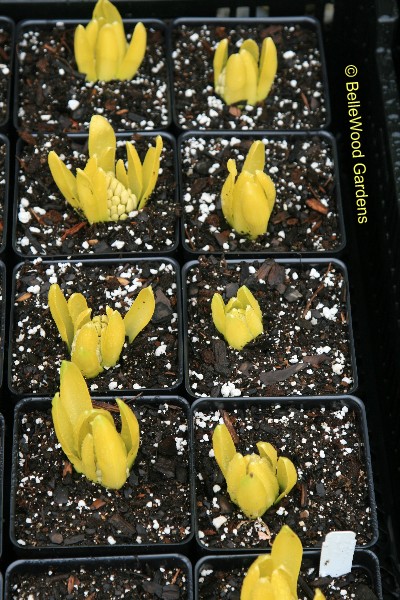
Also muscari and Dutch iris, lots of lilies, a number of alliums, Fritillaria persica and several forms of F. imperialis. The latter two genera were the most problematic. Both fritillaria and allium, Marc learned, began growing when it was their time to grow, even in the dark, even in the cold.
Cold was the key. Once potted the bulbs were held at 50° to 65° Fahrenheit for 3 to 4 weeks. In January they received their first cooling, down to 40° to 45° F. The third stage was to place them into suspended animation, two and a half months at 32° to 35° F. Marc even got tricksy with Scilla peruviana. Let the potted bulbs start growing, get an inch or so tall, then chill them back down. The many pots of Scilla peruviana back in growth, and these winter blooming bulbs will be on display for the show, 5 months out of their natural cycle. Marc confided that he doesn't think this bulb will ever become popular for home or apartment, smelling as the flowers do, of cat pee.
The month-long show will start with tulips, daffodils, hyacinths and fritillaria, and finish with allium and lilies. Timing is critical. Plans are to change out / change over the plants three times. When I visited behind the scenes on April 21, I saw tulips in the Nolen Greenhouses, hyacinths and fritillaria outdoors, narcissus still in the refrigerator containers along with more pots of Fritillaria imperialis, yellow from lack of light but determinedly in bud. They will green up in 7 days, bloom in 10 to 14 days. Tulips bloom in 14 to 20 days, depending upon variety. There is a third refrigerator cargo container, not as accurate in temperature control as the other two, which functions, where needed, as an intermediate stage before the greenhouse. At this time, in the close run-up to the opening of the show, someone is daily checking the growth of bulbs. How tall are the emerging shoots, what’s the height of the flower buds.
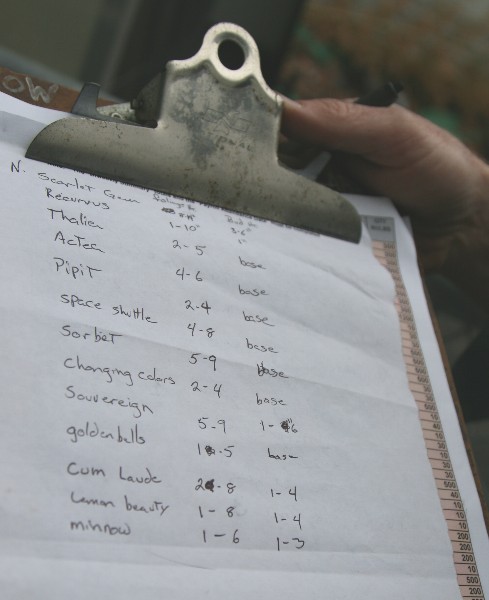
And it worked. Marc and all the staff involved pulled it off, even with
the added complexity of four August-in-April days the weekend before
the week of the show's installation. Press preview on April 30 and they're
under the wire. Moving plants, staging plants, sweeping up and labelling.
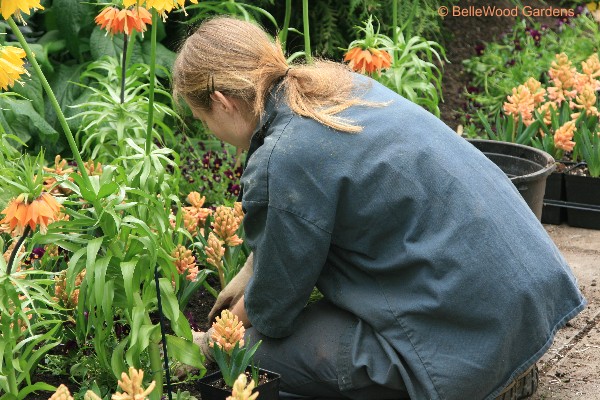

In 2008, staff members of the world famous Keukenhof gardens visited
the New York Botanical Garden to assist with the exhibition's design.
Nearly 50,000 bulbs were generously donated by Dutch bulbs growers,
members of the International Flower Bulb Centre.
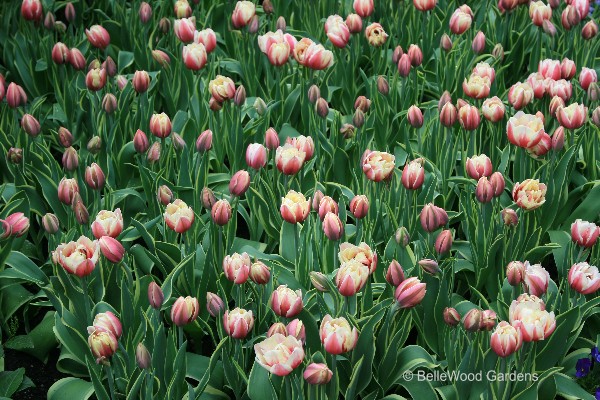
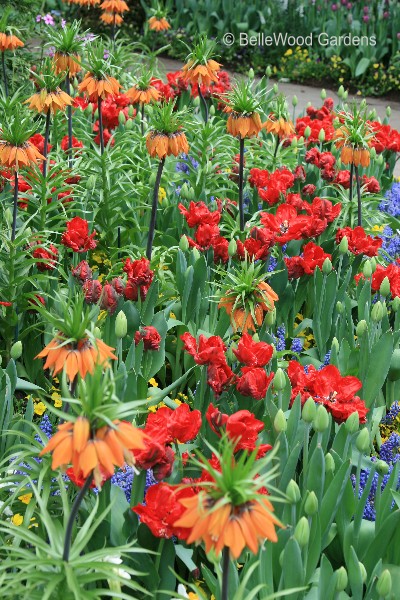
Above, a hot combination of Fritillaria imperialis, crown imperial, and
deep rich dark red parrot tulips. Below, the soft yellow bells of 'Aurea'
with a melange of white and purple tulips, intermingled with pansies.
After the exhibition closes all of the crown imperials will be heeled in,
in an outdoor holding area. Then in early autumn the crown imperial bulbs
will be planted out on the grounds to ornament the garden in years to come.
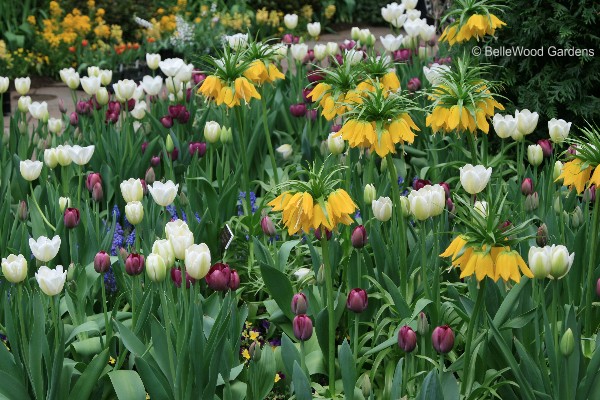
.
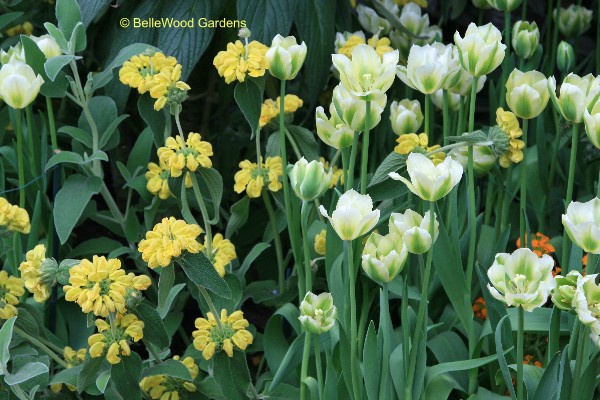
Viridiflora tulips have leaf tissue in their silken petals, adding a touch of green.
Here, cool, white 'Spring Green' pairs up with buttery yellow Phlomis.

Yellow hyacinths, a color not often seen, in elegant display with rich blue Anchusa
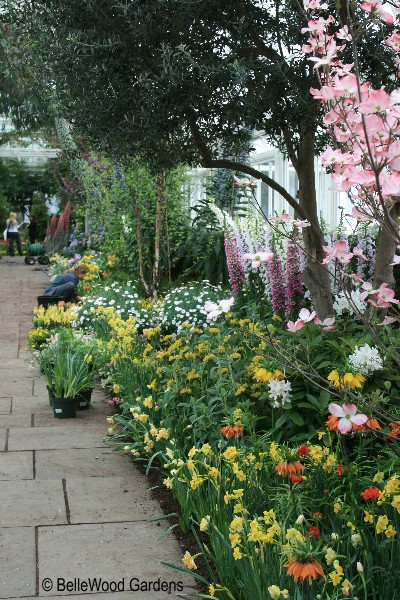
The seasonal display in the conservatory is a marvellous Spring garden under glass,
packed full of flowers, with that delicate perfume that comes with the season.
It was a tremendous amount of work that all involved should take pride in.

The New York Botanical Garden is open year-round, Tuesday through Sunday and Monday federal holidays. Located at Bronx River Parkway (exit 7W) and Fordham Road, it is easy to reach by Metro-North Railroad, subway, or by car. The Glory of Dutch Bulbs: A Legacy of 400 Years is an indoor floral extravaganza.
Back to April 2009